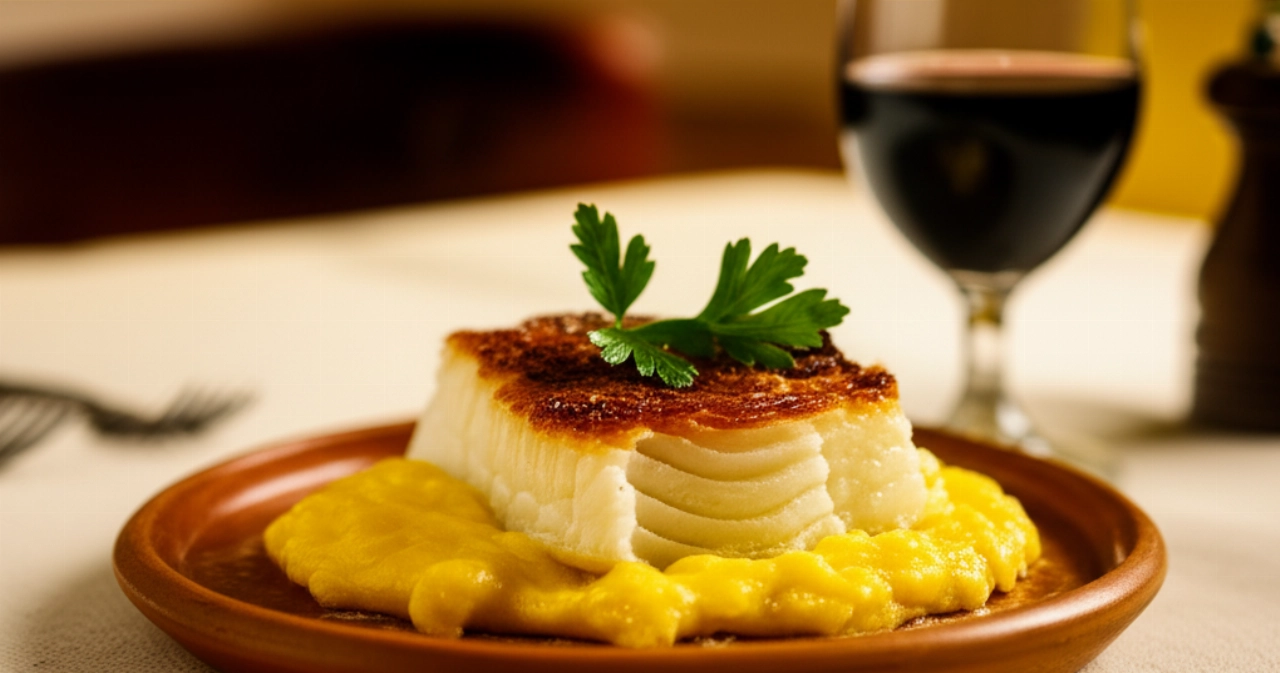Dreaming of bringing a dish to the table that smells of the sea, the land, and authentic Marche tradition? Ancona-style Stockfish is a true masterpiece of our cuisine, a rich and comforting main course capable of conquering even the most demanding palates. But let's face it, preparing stockfish can be a bit daunting: the fear that it might turn out stringy, that it won't absorb flavors well, or that the final result won't live up to expectations. How many times have you given up for fear of wasting precious time and ingredients?
Make yourself comfortable. Here at Search Recipes, your trusted kitchen, we won't just give you a recipe. We'll take you by the hand and guide you step by step, revealing all the secrets to preparing an Ancona-style Stockfish so soft, flavorful, and succulent that it will seem like it came straight from grandma's hands. I guarantee that, by following my advice, success is assured and every bite will be a hymn to true Italian cuisine. Get ready to receive compliments!

Ingredients for an Infallible Ancona-Style Stockfish: The Choice That Makes the Difference
For such an iconic dish, the quality of ingredients is not just important, it's fundamental. It's not just about listing them, but understanding the 'why' behind each choice. Here's what you need and why:
- Pre-soaked Stockfish: This is the heart of the dish. Choose excellent quality stockfish, already soaked and well-beaten. It should be white, firm but not hard, and have a delicate sea scent. If you buy it dry, remember that soaking requires days and constant water changes. Ask your trusted fishmonger; they will advise you best.
- Potatoes: The right potatoes are yellow-fleshed ones, starchy but not too much, that hold their shape well during cooking without completely falling apart, absorbing the sauce's flavor. They are what will give creaminess and substance to the dish.
- Quality Peeled Tomatoes: Not just any passata! Choose whole, ripe, and fleshy peeled tomatoes, preferably San Marzano or similar. They will be the base of your sauce, adding sweetness and color without overpowering the delicate flavor of the stockfish.
- Gaeta or Taggiasca Black Olives: Olives add an unmistakable savory and aromatic touch. Gaeta olives are perfect for their fleshy texture and strong flavor, but Taggiasca olives, being more delicate, also work very well.
- Anchovies in Oil: A couple of fillets, melted into the soffritto, will give an incredible depth of flavor, almost imperceptible but fundamental for balancing the fish's taste. Don't worry, you won't taste anchovy, but only a richer and more complex flavor.
- Garlic and Onion: The aromatic base. Not-too-strong garlic and a finely chopped yellow onion will create the bed on which all the flavor will develop.
- Fresh Rosemary: A sprig of rosemary, added halfway through cooking, will release a balsamic aroma that pairs divinely with the fish and potatoes.
- Extra Virgin Olive Oil: Don't skimp on quality! A good EVO oil, perhaps from Marche, is essential for cooking and enhancing all the flavors.
- Chili Pepper (optional): If you love a touch of vibrancy, a pinch of fresh or dried chili pepper will give that extra kick without overpowering the flavors.
- Dry White Wine: A glass of good quality white wine, like a Verdicchio dei Castelli di Jesi, deglazed at the beginning, will add acidity and complexity to the sauce.

The 4 Mistakes That Make Stockfish Stringy (and How to Avoid Them)
Preparing Ancona-style Stockfish is not difficult, but there are some common mistakes that can compromise the final result. I'm here to warn you and help you avoid these pitfalls:
- Not soaking the stockfish properly (or not choosing good quality pre-soaked stockfish): This is mistake number one. If the stockfish hasn't been soaked correctly, it will remain hard and stringy, and no trick can save it. Rely on an experienced fishmonger or, if you do it yourself, be meticulous with water changes.
- Cooking it for too long or over too high heat: Stockfish requires love and patience. Overly aggressive or prolonged cooking will make it dry and fibrous. It should simmer gently, over low heat, for the time needed to become tender and succulent, but no longer.
- Not respecting resting times: Like many dishes that improve with time, Ancona-style stockfish also benefits from a short rest before being served. This allows the flavors to meld perfectly and the fish to absorb the sauce even better.
- Using poor quality ingredients: If the tomato is acidic, the olives bland, or the oil is not good, the dish will suffer. Every ingredient contributes to the symphony of flavors, and a discordant note can ruin the harmony.
Remember, cooking is also about attention to detail. By avoiding these mistakes, you're already halfway to success!

The Extra Touch: The Secret My Marche Grandmother Handed Down to Me
My grandmother, a true kitchen master, always said that Ancona-style Stockfish is not just a recipe, but a ritual. And her secret, which she passed down to me with a smile, was patience and attention to the 'soffritto' (sauté base). 'Don't rush with the garlic and onion,' she would tell me, 'they must become transparent and sweet, without burning, because that's where the flavor is born, it's the base of everything.' And then there was her final touch: a sprig of fresh rosemary, added only halfway through cooking, not at the beginning. 'Rosemary,' she explained, 'is like a delicate perfume: if you put it in immediately, it evaporates. If you put it in later, it releases its aroma when the dish is already hot and envelops it with its unmistakable fragrance.' This small gesture, believe me, makes a huge difference, giving the dish an aromatic depth that will make you say 'Wow!'
Let's Prepare Ancona-Style Stockfish Together: The Step-by-Step Guide
Now that we've revealed the secrets and mistakes to avoid, it's time to get your hands dirty... or rather, into the stockfish! Follow this step-by-step guide and you'll prepare a dish worthy of applause.
Ingredients (for 4-6 servings):
- 800 g pre-soaked and cleaned stockfish
- 600 g yellow-fleshed potatoes
- 800 g quality peeled tomatoes
- 1 medium onion
- 2 cloves garlic
- 50 g pitted black olives (Gaeta or Taggiasca)
- 2 anchovy fillets in oil
- 1 sprig fresh rosemary
- 1/2 glass dry white wine (e.g., Verdicchio)
- Extra virgin olive oil q.b. (as needed)
- Salt and black pepper q.b. (as needed)
- Fresh or dried chili pepper (optional)
Preparation:
- Prepare the Stockfish: If the stockfish is whole, cut it into regular pieces, about 4-5 cm. Check for any remaining bones. Gently pat it dry with paper towels to remove excess water.
- Prepare the Vegetables: Peel the potatoes and cut them into not-too-small chunks (about 3 cm). Finely chop the onion and garlic cloves. Drain the peeled tomatoes and lightly crush them with a fork. Pit the olives if necessary.
- The Aromatic Soffritto: In a large saucepan (preferably earthenware or thick-bottomed), pour a generous amount of extra virgin olive oil. Add the chopped onion and garlic. Sauté over low heat for about 5-7 minutes, until the onion is transparent and soft. Add the anchovy fillets and let them melt into the oil, stirring gently. If using chili pepper, add it now.
- Deglaze with Wine: Add the stockfish pieces to the soffritto and let them brown lightly on all sides for a couple of minutes. Pour in the white wine and let the alcohol evaporate completely over high heat. This step is crucial for adding depth of flavor.
- Add Tomato and Potatoes: Add the crushed peeled tomatoes and potato chunks. Stir gently to combine all ingredients. Season with salt and pepper.
- The Long Cooking: Cover the saucepan with a lid and lower the heat to minimum. The stockfish should simmer gently, almost "cooking in its own steam." Let it cook for at least 1 hour and 30 minutes, or until the stockfish is very tender and the potatoes are well cooked. Halfway through cooking (after about 45 minutes), add the sprig of rosemary and the black olives. If the sauce becomes too dry, add a ladleful of hot water or vegetable broth, but it's usually not necessary.
- The Warrior's Rest: Once cooked, turn off the heat and let the stockfish rest in its saucepan for at least 15-20 minutes before serving. This will allow the flavors to settle and the dish to reach its perfect consistency.
- Serve and Enjoy: Serve the Ancona-style Stockfish hot, perhaps accompanied by toasted homemade bread croutons, perfect for "scarpetta" (mopping up the sauce) in the delicious gravy.
Tips and Frequently Asked Questions about Ancona-Style Stockfish
Still have some doubts? Don't worry, it's normal! Here are the answers to the most frequently asked questions about Ancona-style Stockfish:
- Can I use baccalà instead of stockfish? No, absolutely not! Although both are preserved cod, stockfish is air-dried cod, while baccalà is salted cod. They have very different textures and flavors. For this recipe, authenticity requires stockfish.
- How do I choose good quality stockfish? Ask your trusted fishmonger. It should be light-colored, almost white, with a firm but not woody texture. If you buy it pre-soaked, make sure it has been treated correctly.
- Can I prepare Ancona-style Stockfish in advance? Absolutely yes! In fact, like many traditional dishes, Ancona-style stockfish is even better the next day, because the flavors have had time to meld perfectly. Store it in the refrigerator in an airtight container and reheat it gently before serving.
- How can I store leftovers? You can store leftover stockfish in an airtight container in the refrigerator for 2-3 days. It is not advisable to freeze it once cooked, as the fish's texture might suffer.
- What is the best wine to pair with it? A good Verdicchio dei Castelli di Jesi, an excellent Marche white wine, is the perfect pairing. Its freshness and minerality balance the richness of the dish.
There you have it! Now you no longer have just a recipe, but all the secrets to bring an Ancona-style Stockfish to the table that tastes of home, tradition, and love. A dish that will make you feel like a true chef, even if it's your first time preparing it. Don't be afraid to experiment and add your personal touch, but start from this solid base and you'll see that applause won't be lacking.
Have you tried our recipe? We are very curious to see your masterpiece! Leave a comment below, tell us how it went, or share a photo on Instagram by tagging @CercaRicette.it. If you loved this journey into Marche cuisine, you can't miss our recipe for Marche Vincisgrassi, a rich and flavorful first course, or for a perfect side dish like Crispy Baked Potatoes. Enjoy your meal!





